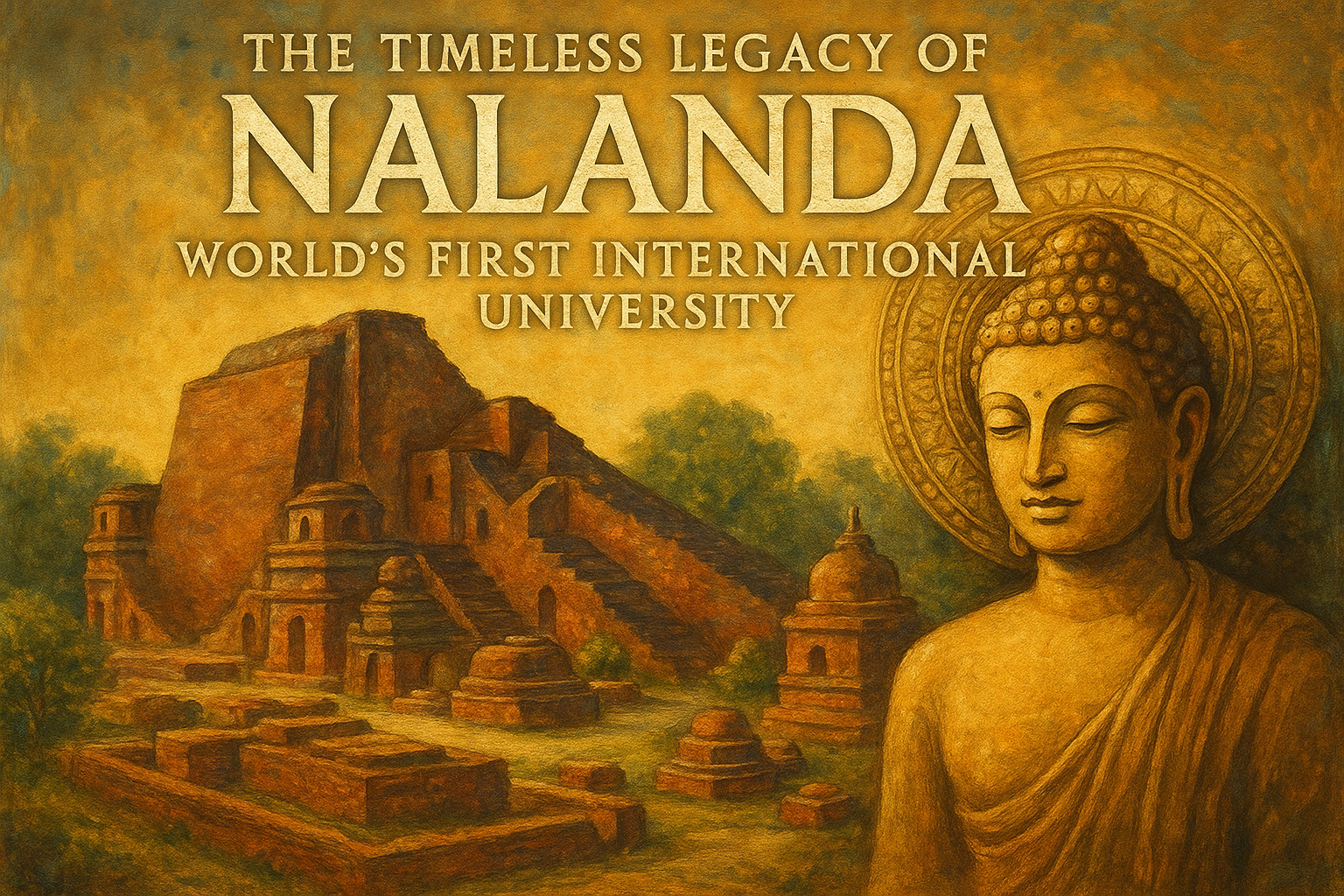
The Timeless Legacy of Nalanda: World’s First International University
Introduction
Nalanda Mahavihāra (ancient Nalanda) was one of the greatest seats of learning in ancient world history. Nestled in what is now Bihar, India, it attracted scholars and students from across Asia—China, Tibet, Korea, Southeast Asia, and more. It flourished roughly from the 5th century CE until the 12th century CE, until its destruction. Ancient Nalanda is remembered not just for its vast library and numerous teachers and students, but also for its disciplined monastic rules, daily rituals, its curriculum that spanned many fields, and its cosmopolitan character. In recent decades, a modern Nalanda University has been revived as an international research-university to continue some of this heritage.
Ancient Nalanda: Rituals, Rules & Education System
Here are what we know (from archaeological records, travellers’ accounts like Xuanzang, I-Tsing, inscriptions, and Buddhist chronicles) about how Nalanda functioned in ancient times, including its rituals, rules, student life, curriculum, administration, etc.
1. Administration & Structure
- Nalanda was organized as a mahavihāra, literally a “great monastery,” but functioning as an international residential university, combining monastic life with scholarly pursuits.
- It had many viharas (monastic dormitories) and temples; complexes of lecture halls, meditation halls, libraries.
- Governance was by senior monks/teachers; councils of elders who decided on rules, administration, welfare.
2. Entrance, Age, Student Admission
- There was a minimum age requirement cited in some sources: Chinese monk I-Tsing noted that students usually were at least 20 years old when admitted.
- Admission was rigorous; students were expected to be well versed in foundational learning (grammar, previous learning) before taking advanced courses. Debates, prior merit and scholarship likely mattered.
3. Daily Routine & Rituals
- A highly structured schedule. Every day: morning bell signaling bath; followed by worship/ritual or prayers, study, discussions. In the evening, “chaityavandana” ceremonies (a ritual of worship of the shrine/temple), chanting, hymns.
- Students lived in viharas, sharing residences; monastic discipline applied. They did chores: cleaning, kitchen duties, etc. The student had duties towards master/teacher, including assisting in certain rituals or support tasks.
- Observance of Buddhist moral code (vinaya): non-violence, truth, respect, celibacy for monks; perhaps others depending on monastic status.
4. Curriculum & Subjects
Nalanda was not limited to Buddhist theology only. Its curriculum was broad, multidisciplinary. Key subjects included:
- Buddhist studies: Mahāyāna, doctrines, Vinaya, Abhidharma, the eighteen Nikāya traditions etc.
- Vedic studies: Vedas, Upanishads, sacrificial ritual knowledge, ritual theory, and philosophical tradition. Grammar, linguistics, Shabdavidyā.
- Logic (Hetuvidyā), debate, philosophical disagreement and dialectics. Students had to defend positions, engage with multiple schools.
- Medicine (Chikitsavidyā), Ayurveda etc.
- Astronomy (Jyotiṣa), mathematics (Gaṇita), many sciences of the time.
- Other subjects: arts and crafts, possibly pragmatic / ritual arts, mantra, tantra; philology; sometimes even medicine ancillary disciplines.
5. Rules, Discipline & Rituals
- Monastic rules: students/monks bound by Vinaya (the monastic code) governing conduct, interactions, dress, speech, behavior. Violations might lead to penance or expulsion.
- Rituals of worship: daily prayers or rituals to Buddha statues, chaityas (temple halls), chanting etc.
- Ceremonies for significant days: installation of new images, arrival of important teachers, victories in religious debates, new students; these involved collective rituals.
6. Library, Manuscripts & Research
- Nalanda housed large libraries (like Dharmaganja) with many manuscripts. Students and teachers had access; copying, translating manuscripts were key activities.
- The breadth of texts was enormous, including Buddhist canonical texts, commentaries, and works in many languages. The multilingual aspect: Sanskrit, Pali etc.
7. Support, Funding & Patronage
- The institution was patronised by various kings and rulers over the centuries: Pala dynasty being especially notable. Devapala, for example.
- Local villages and communities supported Nalanda: food supplies, donations, maintenance etc. There were kitchens, storage rooms, sustenance systems.
- Education was free for students in most cases; no tuition fees in the way modern universities charge.
What Remains / Modern Nalanda University & Differences
Since the destruction in the 12th century, Nalanda lay in ruins for many centuries. In recent decades, especially in early 21st century, there has been revival: Nalanda University (Rajgir, Bihar) reestablished under Indian law (Act of Parliament) with support of multiple countries, as an international research-university. Below are major continuities and differences.
Continuities (Heritage Preserved)
- The international character: students and scholars from across India and abroad. Nalanda University is supported by participating countries (East Asia Summit countries) and admits international students.
- Multidisciplinary curriculum: modern Nalanda offers Masters and PhD programs in Buddhist Studies, Philosophy, Comparative Religion, Historical Studies, World Literature, Ecology & Environment Studies, International Relations and Peace Studies etc.
- Emphasis on research, discourse, seminars etc. A sense of rigorous academic inquiry is preserved.
- Residential character: students often stay on campus (especially PhD / full-time) with hostels.
Differences (Modern vs Ancient)
| Ritual & Religious Instruction | Strongly Buddhist rituals, daily worship, moral discipline via monastic code, religious debate, image worship etc. | More secular, academic; although Buddhist Studies is an academic discipline, ritual worship is not central to all students; discipline less monastic, more like modern university rules. |
| Admission Age & Criteria | Admission required prior mastery / merit; often older, and likely selection by intellectual ability. Minimum age ~20 per some reports. | Modern admissions require a Bachelor’s degree for Masters; standardized criteria; language proficiency; Statement of Purpose, interviews etc. |
| Funding & Cost | Free education, supported by patronage, donations, state/king contributions; no tuition in the modern sense. Local communities helped sustain. | Modern Nalanda charges tuition fees; there are application fees; residential facilities; likely scholarships etc; more formal financial management. |
| Scope of Subjects | Centered largely on religious, philosophical, and traditional sciences (grammar, logic, medicine, astronomy etc.), with debate and religious traditions key. Some arts, ritual, languages. | Broad modern disciplines including environmental studies, sustainable development, modern social sciences, literature, etc. Modern tools, methodologies. |
| Rules & Lifestyle | Monastic discipline, life in viharas, chores, ritual duties, observance of moral codes, probably celibacy for monks, strict obedience to teacher, uniform/simple dress etc. | Modern students live in hostels, but romantic features of monastic life are largely absent; dress codes are standard but not monastic; not all students are monks; more freedom in lifestyle. |
| Rituals & Daily Prayers | Daily worship, chanting, rituals tied to Buddhist theology. | These practices are preserved more as academic or spiritual options; not compulsory for everyone. |
Some Legends, Tales & Key Legacy Elements
- The library of Nalanda was enormous—multiple stories in the main library (Dharmaganja). Many manuscripts, commentaries, texts from different traditions. It was considered among the great libraries of the ancient world. Its loss is lamented.
- Famous scholars: Xuanzang (Hiuen Tsang) from China studied here. Shilabhadra was a notable teacher. The academic journeys of many foreign scholars testify to its reputation.
- Cultural interchange: students came from far away; languages were many; ideas flowed across boundaries.
- Ritual of Samavartanam (in broader Indian education context) marked graduation; though not necessarily specific to Nalanda, it reflects how learning was seen as a rite of passage.
- Physical architecture: viharas, temples, meditation halls- the layout ensured fusion of learning, worship, living, meditating. Shared spaces, gardens, ponds etc.
Modern Nalanda University: Admission Procedure Now
Here’s how students can seek admission to modern Nalanda University:
- Programs Offered
- The university offers Master’s (M.A., M.Sc., M.B.A.) programs in areas such as Hindu Studies (Sanātana Dharma), World Literature, Ecology & Environment Studies, Historical Studies, Buddhist Studies, Philosophy & Comparative Religions, International Relations & Peace Studies, Economics, Mathematics etc.
- Also Ph.D. programs are available in many disciplines.
- Eligibility Criteria
- For Indian students: Minimum requirement is a Bachelor’s degree (10+2+3) with certain percentage (often ~60%) or equivalent grades.
- For international students: Equivalent qualifications; proof of proficiency in English (TOEFL, IELTS etc) or having done full-time degree taught in English.
- For PhD candidates: Master’s degree with good grades, possibly prior research or publication record, letters of recommendation, Statement of Purpose, research proposal.
- Application Process
- The application is online and paperless (for many programs).
- Must fill in the application form, submit required documents: transcripts, SoP, possibly a self-introductory note, reference letters, sometimes sample of written work.
- There’s usually an application fee. For Indian and international students it may differ.
- Selection
- Shortlisting based on eligibility, academic performance, completeness of application.
- Then interviews (in some cases via video conference) and possibly evaluation of written work.
- Merit is a major factor. For PhD students, research proposal and references weigh heavily.
- Fees / Financial Aid
- Tuition and residential fees will apply. For full-time PhD students, a stipend is available.
- Residency
- Many programs are fully residential especially for PhD / full-time candidates. Housing provided in hostels.
How Can Students Take Admission in Nalanda Now: Step-by-Step
Here is a step-by-step guide for an applicant:
- Explore Program Offered: Visit the official Nalanda University website, review the list of Master’s / PhD courses offered this year. Decide domain of interest.
- Check Eligibility: Make sure you meet educational qualifications, language proficiency, grades etc.
- Prepare Documents: Transcripts, degree certificates; references; Statement of Purpose; research proposal (especially for PhD); proof of English proficiency if required.
- Submit Application Online: Fill the online portal, attach documents, pay the application fee. Keep track of deadlines.
- Interview / Written Work: If shortlisted, participate in interview, send any required writing samples.
- Acceptance & Payment / Registration: If selected, receive provisional offer, pay relevant fees (tuition, admission fee etc.), register for courses.
- Relocation / Residence: Arrange for residence if required; get hostel allotment; finalize travel and visa if international student.
The Legacy that Nalanda Holds: Why It Still Matters
- Interdisciplinary Learning: The way Nalanda combined religious/philosophical studies with sciences, arts, languages, logic encourages holistic education.
- Internationalism: Scholars from many countries; ideas crossed cultural lines; set a precedent for global scholarship.
- Library & Textual Scholarship: Preservation, commentary, translation, manuscripts—knowledge transmission across generations.
- Debate & Critical Thinking: Not rote learning—students engaged with arguments, philosophical systems, defended positions.
- Monastic Ethics & Discipline: Focus on morality, routine, self-restraint; virtues along with intellectual growth.
- Free or Supported Education & Patronage: Education not always a commodity; communities and rulers supporting learning.
For more precise information, visit Nalanda's official website here- Nalanda University | Home - Nalanda University


















